Plato's Allegory of the Cave: Examining Truth in Modern Society
VerifiedAdded on 2022/09/09
|6
|1162
|15
Essay
AI Summary
This essay delves into Plato's Allegory of the Cave, exploring its philosophical underpinnings and contemporary relevance. The author examines the allegory's core themes of truth, perception, and the nature of reality, drawing connections to Plato's Theory of Forms. The paper presents a detailed analysis of the allegory's visual representation and explores its implications for understanding human consciousness and societal issues. Furthermore, the essay applies the allegory to the contemporary issue of American Police Brutality, illustrating how the concepts of ignorance, enlightenment, and the pursuit of truth resonate in modern society. The author argues that the allegory highlights the importance of education and the challenges of exposing individuals to the truth, even when it clashes with their established beliefs. The essay concludes by emphasizing the enduring value of Plato's work in understanding the complexities of human existence and the ongoing quest for knowledge.
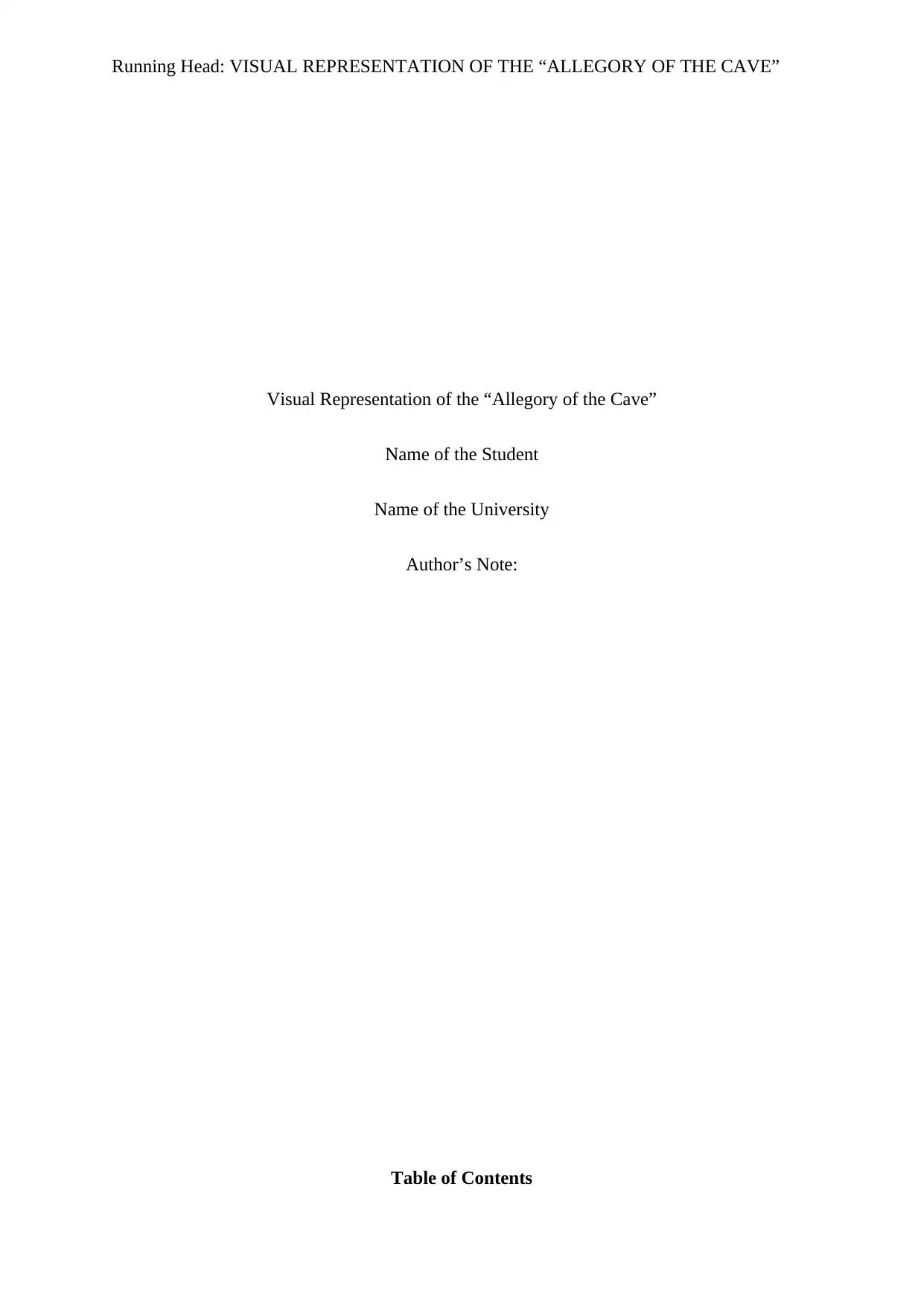
Running Head: VISUAL REPRESENTATION OF THE “ALLEGORY OF THE CAVE”
Visual Representation of the “Allegory of the Cave”
Name of the Student
Name of the University
Author’s Note:
Table of Contents
Visual Representation of the “Allegory of the Cave”
Name of the Student
Name of the University
Author’s Note:
Table of Contents
Paraphrase This Document
Need a fresh take? Get an instant paraphrase of this document with our AI Paraphraser
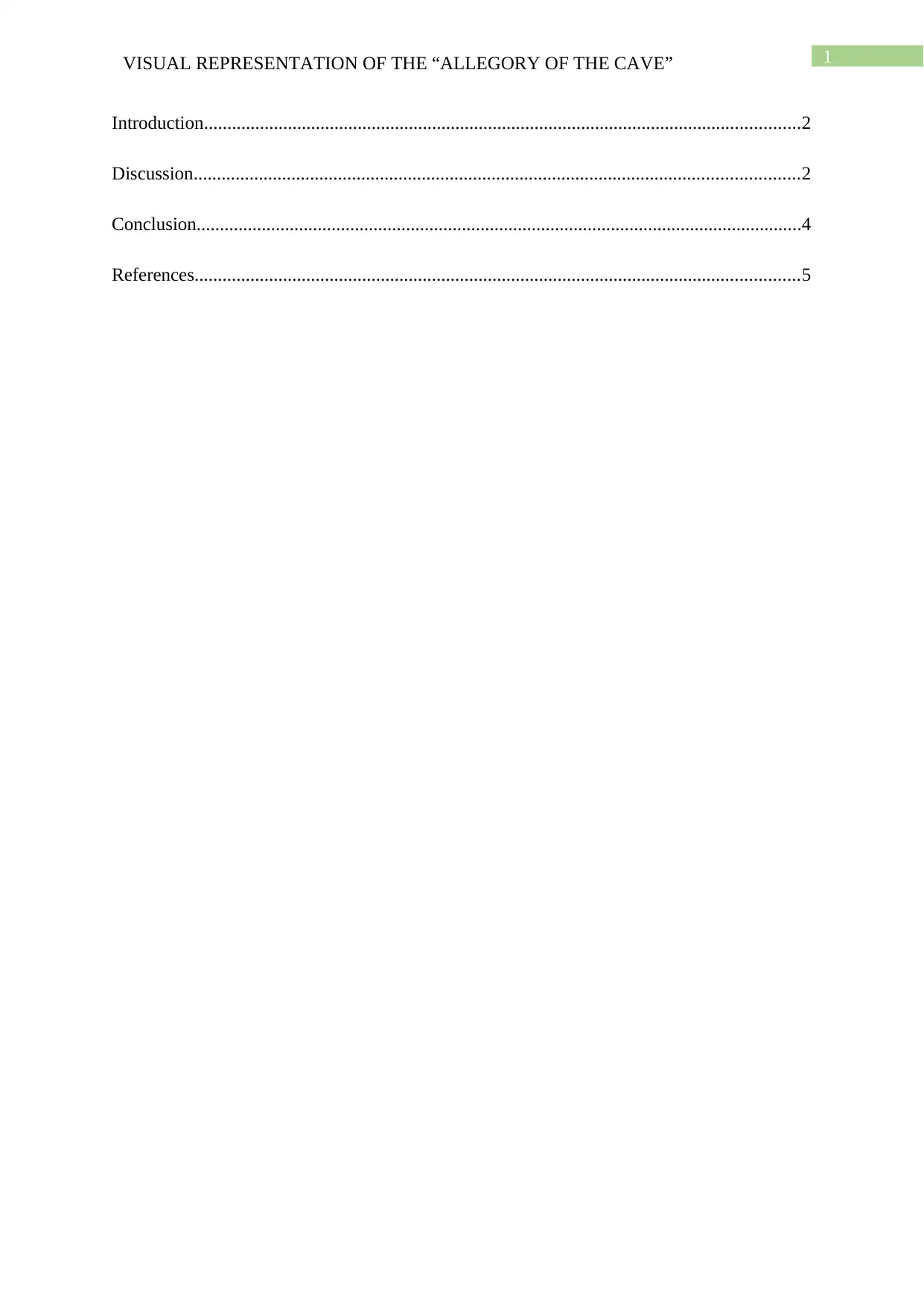
1VISUAL REPRESENTATION OF THE “ALLEGORY OF THE CAVE”
Introduction................................................................................................................................2
Discussion..................................................................................................................................2
Conclusion..................................................................................................................................4
References..................................................................................................................................5
Introduction................................................................................................................................2
Discussion..................................................................................................................................2
Conclusion..................................................................................................................................4
References..................................................................................................................................5

2VISUAL REPRESENTATION OF THE “ALLEGORY OF THE CAVE”
Introduction
The ‘Allegory of the Cave’ in Plato’s Republic VII can be seen as the part of the
philosopher’s attempt to validating his demand of the philosopher’s rule rather than a
democratic government. The paper will show how the Allegory stands for the condition of
the world concerning the standing of the philosophers in the world. The theory can also be
deduced from the understanding of ‘Theory of Forms’ by Plato which recognizes forms of
beings as the ultimate reality rather than material things which are identified based on the
perception through senses, the paper aims to bring the understanding of the allegory of the
cave in terms of contemporary issue of American Police Brutality.
Discussion
The allegory presented by Plato presents the imagery of light and dark in terms of
human consciousness and understanding of their exposure to truth. The example of people
living inside the cave can be seen as the representation of people who stays ignorant on the
face of truth and accepts the reality of what they see and accepts on their own (Agrati, 2018).
People bound inside the cave with no access to the reality of the world except for the shadow
and the echoed sound of the movements, and animals are the only source of exposure to
them. It represents the case of the general population whose scope of view was too narrow to
understand the broader point of view of the philosophers.
The light from the Sun which brings about the change in the man leading him to
accept the reality of the things over the shadows inside the cave, which he has spent his life
accepting as the ultimate truth (Castro, 2017). One can see the rhetorical formulation of the
society in which man lives and perceives what he thinks is the right way. The understanding
of the truth, according to Plato, is only the shadow which the general population accepts as
their truth and the man who is finally freed to see the truth understand the universal and the
ultimate light of the Sun is the philosophers. The allegory is the manifesto for his argument
Introduction
The ‘Allegory of the Cave’ in Plato’s Republic VII can be seen as the part of the
philosopher’s attempt to validating his demand of the philosopher’s rule rather than a
democratic government. The paper will show how the Allegory stands for the condition of
the world concerning the standing of the philosophers in the world. The theory can also be
deduced from the understanding of ‘Theory of Forms’ by Plato which recognizes forms of
beings as the ultimate reality rather than material things which are identified based on the
perception through senses, the paper aims to bring the understanding of the allegory of the
cave in terms of contemporary issue of American Police Brutality.
Discussion
The allegory presented by Plato presents the imagery of light and dark in terms of
human consciousness and understanding of their exposure to truth. The example of people
living inside the cave can be seen as the representation of people who stays ignorant on the
face of truth and accepts the reality of what they see and accepts on their own (Agrati, 2018).
People bound inside the cave with no access to the reality of the world except for the shadow
and the echoed sound of the movements, and animals are the only source of exposure to
them. It represents the case of the general population whose scope of view was too narrow to
understand the broader point of view of the philosophers.
The light from the Sun which brings about the change in the man leading him to
accept the reality of the things over the shadows inside the cave, which he has spent his life
accepting as the ultimate truth (Castro, 2017). One can see the rhetorical formulation of the
society in which man lives and perceives what he thinks is the right way. The understanding
of the truth, according to Plato, is only the shadow which the general population accepts as
their truth and the man who is finally freed to see the truth understand the universal and the
ultimate light of the Sun is the philosophers. The allegory is the manifesto for his argument
⊘ This is a preview!⊘
Do you want full access?
Subscribe today to unlock all pages.

Trusted by 1+ million students worldwide
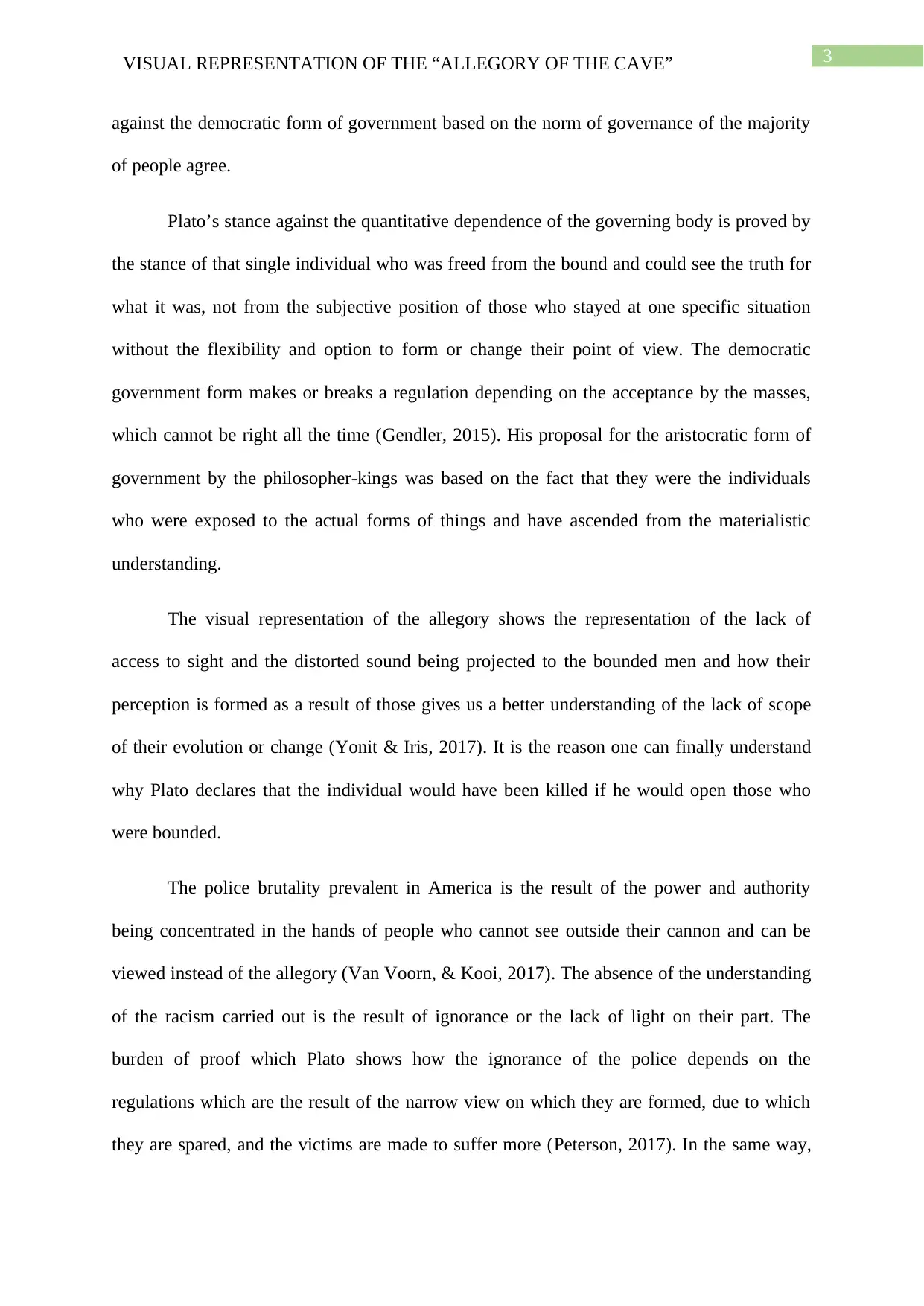
3VISUAL REPRESENTATION OF THE “ALLEGORY OF THE CAVE”
against the democratic form of government based on the norm of governance of the majority
of people agree.
Plato’s stance against the quantitative dependence of the governing body is proved by
the stance of that single individual who was freed from the bound and could see the truth for
what it was, not from the subjective position of those who stayed at one specific situation
without the flexibility and option to form or change their point of view. The democratic
government form makes or breaks a regulation depending on the acceptance by the masses,
which cannot be right all the time (Gendler, 2015). His proposal for the aristocratic form of
government by the philosopher-kings was based on the fact that they were the individuals
who were exposed to the actual forms of things and have ascended from the materialistic
understanding.
The visual representation of the allegory shows the representation of the lack of
access to sight and the distorted sound being projected to the bounded men and how their
perception is formed as a result of those gives us a better understanding of the lack of scope
of their evolution or change (Yonit & Iris, 2017). It is the reason one can finally understand
why Plato declares that the individual would have been killed if he would open those who
were bounded.
The police brutality prevalent in America is the result of the power and authority
being concentrated in the hands of people who cannot see outside their cannon and can be
viewed instead of the allegory (Van Voorn, & Kooi, 2017). The absence of the understanding
of the racism carried out is the result of ignorance or the lack of light on their part. The
burden of proof which Plato shows how the ignorance of the police depends on the
regulations which are the result of the narrow view on which they are formed, due to which
they are spared, and the victims are made to suffer more (Peterson, 2017). In the same way,
against the democratic form of government based on the norm of governance of the majority
of people agree.
Plato’s stance against the quantitative dependence of the governing body is proved by
the stance of that single individual who was freed from the bound and could see the truth for
what it was, not from the subjective position of those who stayed at one specific situation
without the flexibility and option to form or change their point of view. The democratic
government form makes or breaks a regulation depending on the acceptance by the masses,
which cannot be right all the time (Gendler, 2015). His proposal for the aristocratic form of
government by the philosopher-kings was based on the fact that they were the individuals
who were exposed to the actual forms of things and have ascended from the materialistic
understanding.
The visual representation of the allegory shows the representation of the lack of
access to sight and the distorted sound being projected to the bounded men and how their
perception is formed as a result of those gives us a better understanding of the lack of scope
of their evolution or change (Yonit & Iris, 2017). It is the reason one can finally understand
why Plato declares that the individual would have been killed if he would open those who
were bounded.
The police brutality prevalent in America is the result of the power and authority
being concentrated in the hands of people who cannot see outside their cannon and can be
viewed instead of the allegory (Van Voorn, & Kooi, 2017). The absence of the understanding
of the racism carried out is the result of ignorance or the lack of light on their part. The
burden of proof which Plato shows how the ignorance of the police depends on the
regulations which are the result of the narrow view on which they are formed, due to which
they are spared, and the victims are made to suffer more (Peterson, 2017). In the same way,
Paraphrase This Document
Need a fresh take? Get an instant paraphrase of this document with our AI Paraphraser
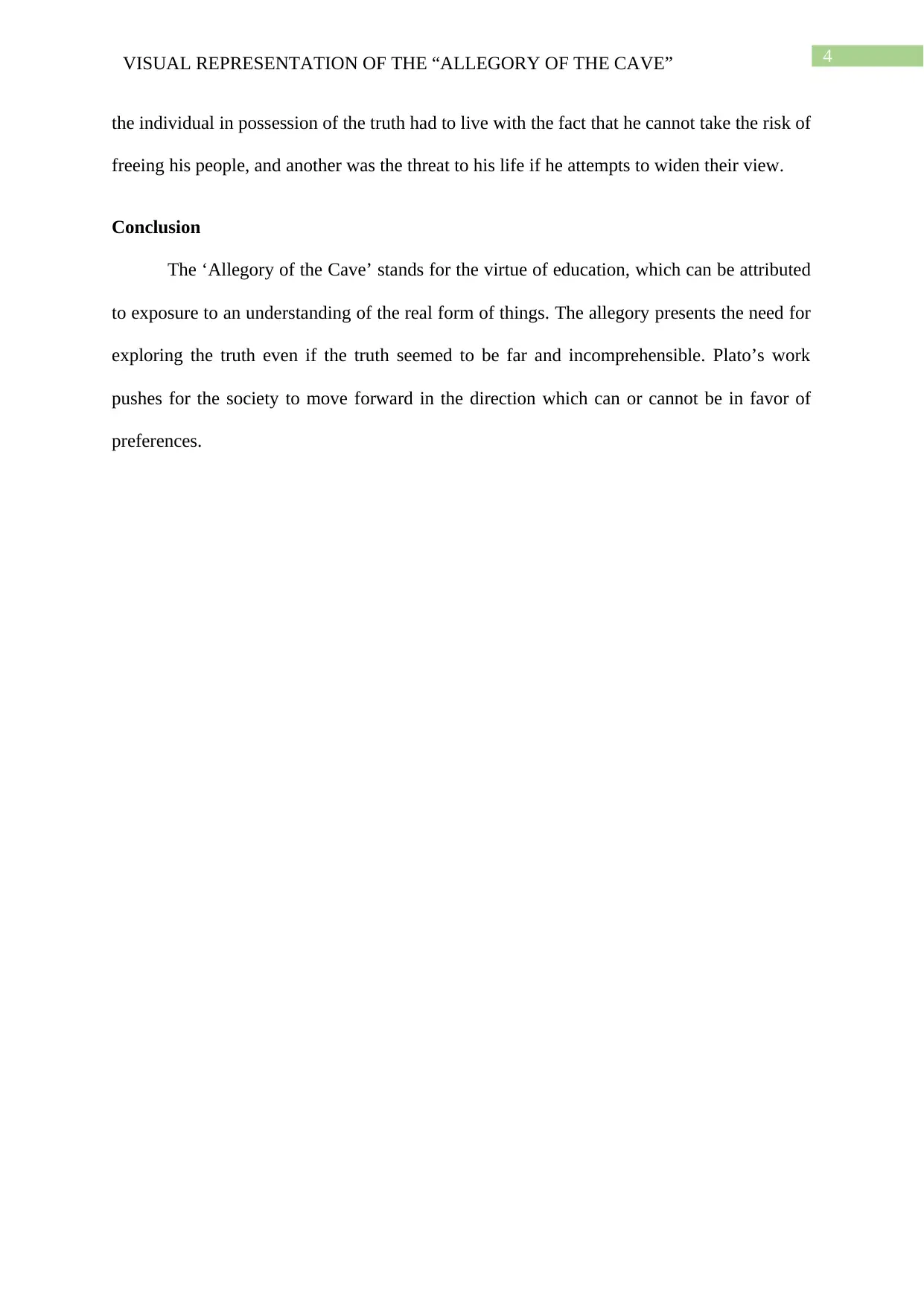
4VISUAL REPRESENTATION OF THE “ALLEGORY OF THE CAVE”
the individual in possession of the truth had to live with the fact that he cannot take the risk of
freeing his people, and another was the threat to his life if he attempts to widen their view.
Conclusion
The ‘Allegory of the Cave’ stands for the virtue of education, which can be attributed
to exposure to an understanding of the real form of things. The allegory presents the need for
exploring the truth even if the truth seemed to be far and incomprehensible. Plato’s work
pushes for the society to move forward in the direction which can or cannot be in favor of
preferences.
the individual in possession of the truth had to live with the fact that he cannot take the risk of
freeing his people, and another was the threat to his life if he attempts to widen their view.
Conclusion
The ‘Allegory of the Cave’ stands for the virtue of education, which can be attributed
to exposure to an understanding of the real form of things. The allegory presents the need for
exploring the truth even if the truth seemed to be far and incomprehensible. Plato’s work
pushes for the society to move forward in the direction which can or cannot be in favor of
preferences.
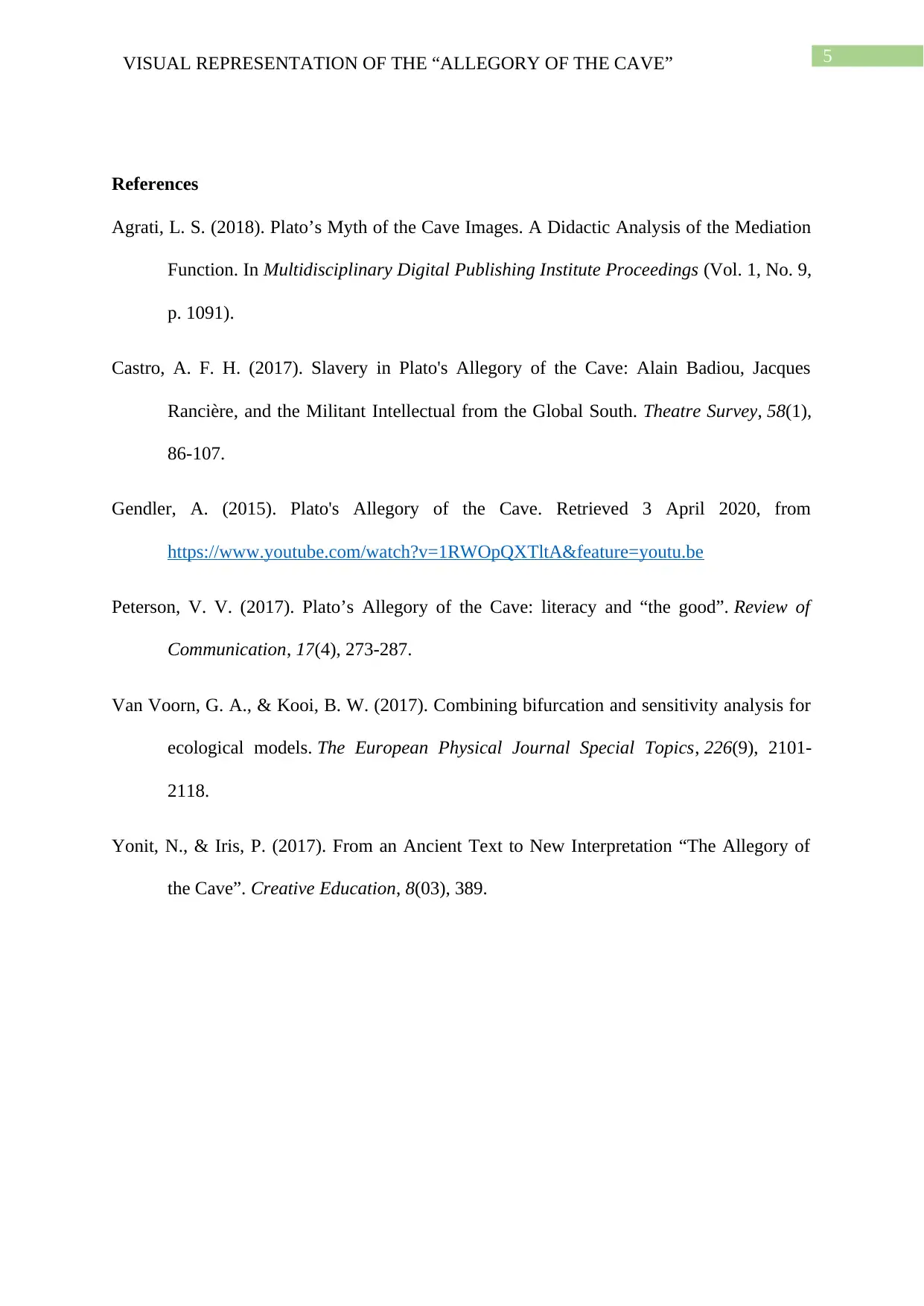
5VISUAL REPRESENTATION OF THE “ALLEGORY OF THE CAVE”
References
Agrati, L. S. (2018). Plato’s Myth of the Cave Images. A Didactic Analysis of the Mediation
Function. In Multidisciplinary Digital Publishing Institute Proceedings (Vol. 1, No. 9,
p. 1091).
Castro, A. F. H. (2017). Slavery in Plato's Allegory of the Cave: Alain Badiou, Jacques
Rancière, and the Militant Intellectual from the Global South. Theatre Survey, 58(1),
86-107.
Gendler, A. (2015). Plato's Allegory of the Cave. Retrieved 3 April 2020, from
https://www.youtube.com/watch?v=1RWOpQXTltA&feature=youtu.be
Peterson, V. V. (2017). Plato’s Allegory of the Cave: literacy and “the good”. Review of
Communication, 17(4), 273-287.
Van Voorn, G. A., & Kooi, B. W. (2017). Combining bifurcation and sensitivity analysis for
ecological models. The European Physical Journal Special Topics, 226(9), 2101-
2118.
Yonit, N., & Iris, P. (2017). From an Ancient Text to New Interpretation “The Allegory of
the Cave”. Creative Education, 8(03), 389.
References
Agrati, L. S. (2018). Plato’s Myth of the Cave Images. A Didactic Analysis of the Mediation
Function. In Multidisciplinary Digital Publishing Institute Proceedings (Vol. 1, No. 9,
p. 1091).
Castro, A. F. H. (2017). Slavery in Plato's Allegory of the Cave: Alain Badiou, Jacques
Rancière, and the Militant Intellectual from the Global South. Theatre Survey, 58(1),
86-107.
Gendler, A. (2015). Plato's Allegory of the Cave. Retrieved 3 April 2020, from
https://www.youtube.com/watch?v=1RWOpQXTltA&feature=youtu.be
Peterson, V. V. (2017). Plato’s Allegory of the Cave: literacy and “the good”. Review of
Communication, 17(4), 273-287.
Van Voorn, G. A., & Kooi, B. W. (2017). Combining bifurcation and sensitivity analysis for
ecological models. The European Physical Journal Special Topics, 226(9), 2101-
2118.
Yonit, N., & Iris, P. (2017). From an Ancient Text to New Interpretation “The Allegory of
the Cave”. Creative Education, 8(03), 389.
⊘ This is a preview!⊘
Do you want full access?
Subscribe today to unlock all pages.

Trusted by 1+ million students worldwide
1 out of 6
Your All-in-One AI-Powered Toolkit for Academic Success.
+13062052269
info@desklib.com
Available 24*7 on WhatsApp / Email
![[object Object]](/_next/static/media/star-bottom.7253800d.svg)
Unlock your academic potential
Copyright © 2020–2025 A2Z Services. All Rights Reserved. Developed and managed by ZUCOL.
